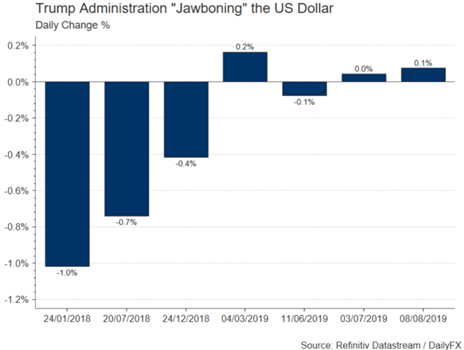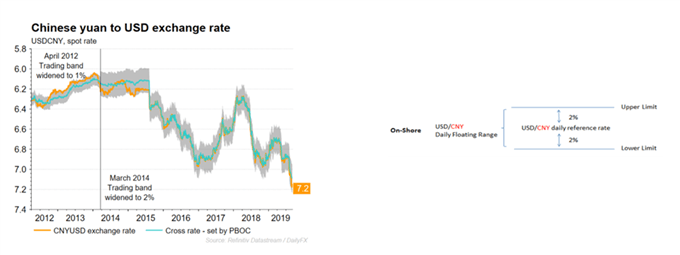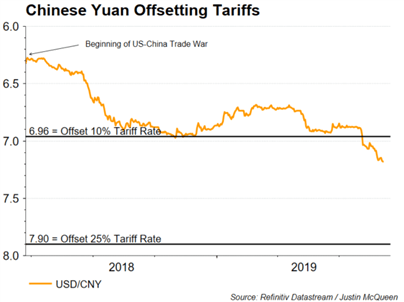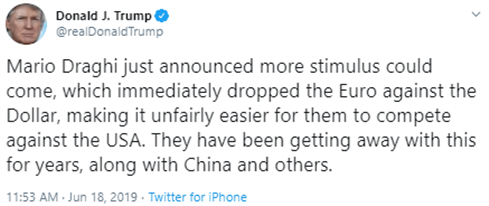Currency Wars Explained: Talking Points:
- What is a Currency War?
- What does it involve, and what “weapons” are commonly used?
- Are we at risk of a Currency War?
What is a Currency War?
A currency war takes place when two or more countries take deliberate actions to lower the value of their currencies in order to gain a competitive advantage over each other. Typically, a weaker currency would allow for a country’s exports to become more affordable to foreign consumers, while making imports more expensive. In turn, this can protect a country’s manufacturers and therefore provide a boost to the economy.
What do Currency Wars Involve?
While trade wars are fought with tariffs, currency wars can be fought in several ways.
Weapons in a Currency War Include:
- Jawboning
- Managed Exchange Rate Regime
- Capital Controls
- Monetary Stimulus
1. Jawboning
Typically, Jawboning occurs when a central bank publicly advocates for a weaker exchange rate via an implied threat to take action. However, this tool is not just limited to central banks as political leaders have also tended to jawbone. That said, the mere threat of an intervention can have the desired effect without the central bank having to act.
US Jawboning (President Trump during US-China Trade War)
In recent times, President Trump has seemingly wanted to shift away from the US “strong dollar policy”, which has been in place since the Bill Clinton administration, to an “America first policy”. This aim is to level the playing field with respect to the trade war against China, who have been criticised for artificially devaluing their currency.
Examples of Jawboning from the Trump Administration

Jan 24th, 2018: (Mnuchin) “A weaker dollar is good for the US as it relates to trade and opportunities”
Jul 20th, 2018: “China, the European Union and others have been manipulating their currencies and interest rates lower, while the U.S. is raising rates while the dollars gets stronger and stronger with each passing day - taking away our big competitive edge. As usual, not a level playing field”
Dec 24th, 2018: “The only problem our economy has is the Fed. They don’t have a feel for the Market, they don’t understand necessary Trade Wars or Strong Dollars”
Mar 4th, 2019: “US Dollar is too strong”
Jun 11th, 2019: “The Euro and other currencies are devalued against the dollar, putting the U.S. at a big disadvantage”
Jul 3rd, 2019: “China and Europe playing big currency manipulation game and pumping money into their system in order to compete with USA. We should match, or continue being the dummies who sit back and politely watch as other countries continue to play their games”
Aug 8th, 2019: “As your President, one would think that I would be thrilled with our very strong dollar. I am not! The Fed’s high interest rate level, in comparison to other countries, is keeping the dollar high, making it more difficult for our great manufacturers”
2. Managed Exchange Rate Regime
A fixed exchange rate system (also known as a pegged exchange rate), is a regime in which a country’s currency value is either fixed to the value of another currency or a basket of currencies. The purpose of this is to allow a currency to trade within a narrow band, which in turn allow a country to intervene directly in the exchange rate. In China they operate with a managed-floating rate system, which is neither free-floating nor fully controlled, the onshore market (CNY) is allowed to float within 2% above or below the reference rate.

What is the Chinese Yuan?: Everything Traders Should Know
China’s FX Regime During US-China Trade War
Since the beginning of the US-China trade war, the Chinese Yuan (CNY) has lost nearly 15% of its value against the US Dollar in what had been criticised by the Trump administration as a deliberate devaluation by the Chinese government. It can be argued that China have used their currency in order to offset the impact of tariffs that have been imposed by the US. As such, in order for China to offset a 10% tariff rate the Chinese Yuan would need to depreciate to 6.96, while a 25% tariff rate would need to see CNY trading at 7.90 in order to offset the impact.

3. Capital Controls
Capital controls are measures that are taken by either a government or a central bank, which regulates the outflow and inflow of foreign capital in a country in order to improve the macroeconomic and financial stability. While capital control can come in several forms such as taxes, tariffs, legislation and volume restrictions, the most widely used method has been to restrict the ability of foreign citizens and residents to exchange a domestic currency for foreign currency.
The use of capital controls can affect a country’s exchange rate with limited inflows resulting in a weaker currency, while limiting outflows can place upward pressure on a country’s exchange rate.
History of Capital Controls
Iceland (2008-2017)
Capital controls were introduced on November 2008 following the collapse of Iceland’s three largest banks during the global financial crisis. The plunge in Iceland’s financial assets prompted a huge wave of capital outflows, which in turn triggered deep declines in the Icelandic Krona and thus pushed inflation higher. Consequently, default risks had spiked, given that many households and businesses were heavily leveraged with foreign-denominated and inflation-indexed debt, therefore, the Central Bank of Iceland acted to restrict foreign currency outflows in order to stabilise the Krona.

India (2013)
In August 2013, India had announced that they would impose capital controls via restrictions on the amount that Indian-domiciled companies and residents could invest abroad. This had been due to the rapid weakening of the Indian Rupee (INR), which had partly stemmed from the Federal Reserves announcement that it had intended to end quantitative easing (QE).
Argentina (2019)
After President Macri suffered a huge defeat to his opposition candidates in a primary vote in August, the Argentine Peso lost a fifth of its value as markets feared a potential return to interventionist policies. As such, Argentina had been forced to re-impose capitals controls, which included the central bank being authorized to restrict purchases of dollars, while residents and non-residents had been restricted to FX purchases of $10,000 and $1000 per month, respectively in order to stem the outflows.
4. Monetary Stimulus
Economic stimulus can have a notable effect of the value of a country’s exchange rate, particularly that of monetary policy, which is a tool used by a country’s central bank. Much like any financial asset, the value of a currency is determined by supply and demand, therefore, money supply within an economy can impact a country’s exchange rate. A central bank can control money supply via setting interest rates or altering a bank’s minimum reserve requirement.
Tight Monetary Policy: Typically, when a central bank raises interest rates, the value of the country’s currency rises. This tends to happen as higher interest rates can attract capital flows into an economy with investors receiving a higher rate of return for the capital that they hold within that economy.
Loose Monetary Policy: A more accommodative policy tends to place downside pressure on a currency, given that the increase in capital available tends to lead to inflationary effects. Consequently, this reduces the purchasing power of a currency making it less valuable.
Find out How Interest Rates Impact FX Markets
Trump’s Criticism of Foreign Monetary Policy
In recent times, the Trump administration has become increasingly critical of other countries and their conduct with regard to monetary policy. Trump has accused them of easing monetary policy in order to weaken their currency and gain a competitive advantage over the US.

Source: Twitter.
Are we at Risk of a Currency War?
Since the beginning of the US-China trade war, risks of a full-blown currency war have been notably elevated. Particularly with the Trump administration becoming increasingly critical of other countries manipulating their currencies. The US officially designated China a currency manipulator for the first time since 1994 as China allowed the Yuan to fall to its lowest level in over a decade. In turn, this has raised concerns that the US may attempt to take steps and intervene in FX markets to weaken the US Dollar.
That said, currency fluctuations have largely been due to spillover effects stemming from economic policies that have been used in order to stimulate growth as opposed to deliberately weakening a currency. While G20 finance minister have also continued to pledge that nations should not target exchange rates for a competitive edge.
RESOURCES FOR FOREX & CFD TRADERS
Whether you are a new or experienced trader, we have several resources available to help you; indicator for tracking trader sentiment, quarterly trading forecasts, analytical and educational webinars held daily, trading guides to help you improve trading performance, and one specifically for those who are new to forex.
--- Written by Justin McQueen, Market Analyst
To contact Justin, email him at Justin.mcqueen@ig.com
Follow Justin on Twitter @JMcQueenFX






